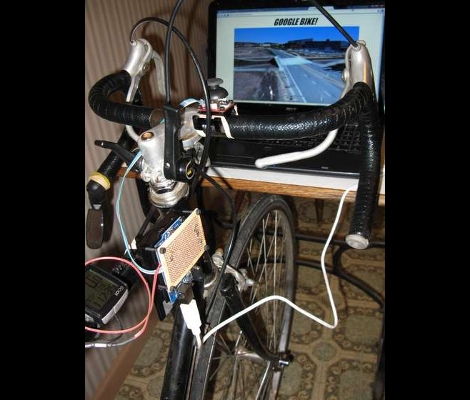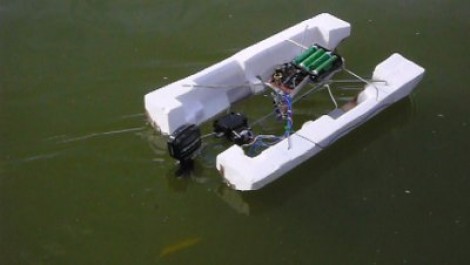There’s the quiet serenity of paddling through the backwoods in a canoe, and then there’s this. It’s a lawnmower motor powered canoe that comes complete with steering wheel, throttle, and a stereo system. To keep the craft balanced the driver rides in the front seat while the motor is hanging off the stern of the boat. The biggest trick is not swamping the thing while getting the motor running, but future plans do include adding an electric starter. There is a kill switch for safety and it appears that top speed will not cause any stability issues. It’s hard to tell for sure from the video after the break, but it sure does seem to be loud!
Month: January 2011
Hackaday Sort Of Going To C.E.S.

We have decided that C.E.S. just really isn’t as much of a hacker mecca as we would have wished. Sure there were brilliantly shining walls of new 3d televisions and cellphones and camcorders as far as the eye could see, but there was mainly just tons of marketing for very little innovation, and much less hacker-centric gear than we had hoped. We had fun and tried to keep things interesting, but just couldn’t justify sending people from all over the country to Vegas for a week this year.
[Greg] had planned on going anyway, so we’ll still get a few updates when he finds the bits that interest us. He should also be snapping pictures and tossing them on twitter throughout the show. Be sure to let him know what you would like to see.
Timelapse Photos For All!

Find yourself wanting to do some timelapse but lacking the equipment? Why not build your own time lapse rig as seen in instructables how to by [Constructer]. To accomplish this, all you will need is a little wood, screws, a motor, and some batteries. The how-to says you can add extra voltage to speed up the rate of taking photos, or conversely reduce voltage to slow it down. We especially like the simplicity of this mechanical approach. No timers, no programming, only a motor. One downfall of this simplistic approach, however is that your “gap” between pictures will increase as your battery dies.
More Bike-controlled Google-travelling

This is becoming such a popular hack we figure someone needs to come up with a name for it like Google-travelling or Google-cising (exercising with Google). It’s a bike controller for Google Earth. [Braingram] broke out his road bike, setting it up in the trainer in front of his laptop. If you already have a computer with a cadence sensor this will be a snap. These measure the crank rotation using a magnet and reed switch. So as not screw up his summer biking [Braingram] spliced into the sensor while leaving it attached to the bike computer. From there it is read by an Arduino which also monitors an analog joystick attached to the handlebars. A little bit of Python scripting and you’ll be ready to go.
Be sure to check out some of the other variants like using an exercise bike, or adding a wearable display.
Driving An 8-digit Split Flap Display

[Markus] got his hands on a split-flap display and built a controller for it. These sometimes can be found on really old alarm clocks, but [Markus] was a lucky-duck and managed to acquire this large 8-digit display which previously made its home in a railroad station. They work like a Rolodex, mounting flaps around a cylinder for a full alpha-numeric font set.
A PIC 12F683 was selected to control the display, using optoisolation to separate the 42V display motors from the driver circuit. From the video after the break we think he did a wonderful job of getting this working. It only takes six I/O pins to control and the sound and look of the digits scrolling leaves us quite jealous.
So what’s he got in store for it? The first thing he did was use it to count down to the New Year.
Controlling Real Objects Using Minecraft

Most augmented reality takes images of the real world and superimposes virtual data on top of them. [Michael Winston Dales] went a different direction, using the virtual world of Minecraft to control objects in the physical world. In the video after the break you can see him use switches that he built inside the game to turn the LEDs pictured above on and off. You’ll also notice that in-game sign instructing a player to stand in one spot to Tweet. Since Minecraft is written in Java there are some mods that allow you to hook onto in-game events. [Michael] does just that, triggering his own scripts to send data to an Arduino, or use a Twitter API. Now this something that should be used with the Minecraft ALU. It takes the sandbox method of gaming to a new place, doesn’t it?
RC Pontoon From A Toy Car

[Kevin Sandom] built this boat using a radio controlled toy car. The two pontoons are recycled from Styrofoam packaging material using some thick wire to connect them and provide a framework for the propulsion and control circuitry. The motor itself is a hobby outboard, which really only required [Kevin] to develop a method for steering. He walks us through the build process in the video after the break, where we find out that the original toy has a pretty bad design flaw. It seems the car used four AA batteries to drive the motor, but one of the four batteries was also used separately from the other three to power the control circuitry. Running that battery down faster than the others shortens the life of the whole.
This is considerably easier than the underwater ROV hacks we’ve seen before. We do think that it would make for a fun weekend project, and we’d bet you’ll get some weird looks for piloting what appears to be garbage around a pond.











